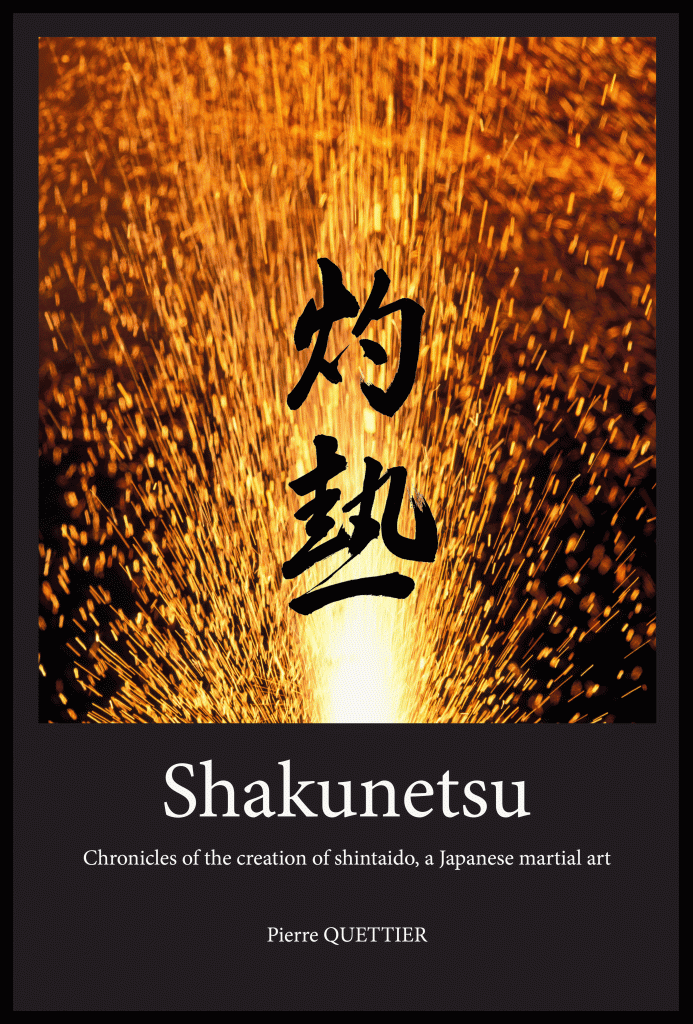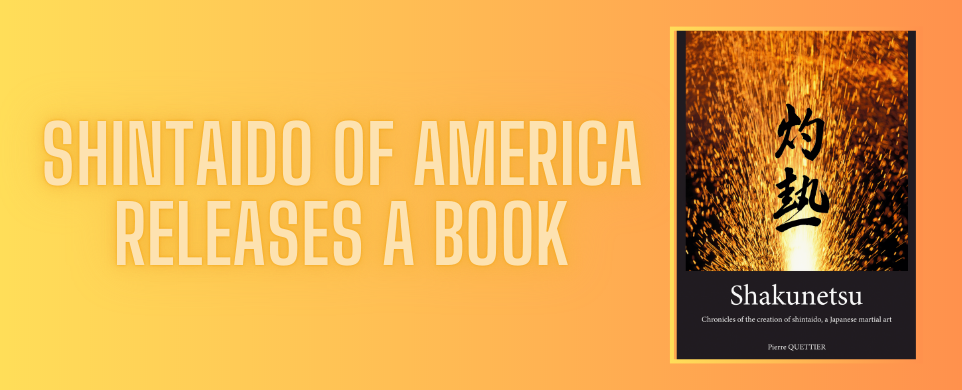Shintaido of America (SOA) is honored to announce the release of the English version of Shakunetsu; Chronicles of the Creation of Shintaido, a Japanese Martial Art. The goal of this collective biography is to provide the stories of many who studied Shintaido in the 1960’s and 1970’s. Pierre Quettier, author of the book, shares his academic analysis of these interviews.
Shakunetsu was first released in French in January 2022. In October 2022 the board of SOA agreed to sponsor the efforts to release an English version of this book. A group of five, Peter Furtado, Nancy Billias, Lee Seaman, Lee Ordeman, and Pierre Quettier guided by the coordination efforts of HF Ito, undertook the editing and proofreading of the English version.

First let’s understand the time and setting when the creation of Shintaido was being developed.
Pierre Quettier, Shintaido General Instructor, author, and sociologist states:
“In the extraordinary burst of the sixties, a group of young Japanese idealists embarked on a quest typical of the time: to break down the cultural and class barriers of the venerable budō to bring the essence to the greatest number. They founded Rakutenkai, the « society of optimists », then, in 1975, a brand new discipline, Shintaïdō.”
Peter Furtado, Shintaido Senior Instructor, Journalist, and historian writes in the foreword:
“This unique book is complex in its ambition and structure. At its heart is the raw material of history – it brings together the oral testimony of 19 Rakutenkai members who describe in their own words how they came to join, what they were seeking and what they found. But this is supported, and given meaning, by the more academic commentary of sociologist and shintaido instructor Pierre Quettier, who carefully places their testimony in the contexts of the Japanese martial and other arts, and of the youth culture – in Japan and around the world – of the time, which had many similarly grand ambitions to change the world, though taking a different path up the mountain. He also offers a personal, honest, and sometimes painful account of the process of meeting the contributors and assembling the texts. As a social scientist who takes the name of that discipline seriously, he sticks closely to the evidence he has collected, declining to conjecture or judge, and refusing to repeat myths unless they can be grounded in fact. In the introduction, he explains the physically and emotionally arduous – and extended – process of preparing this work.”
HF Ito, Master Instructor, and co-founder of SOA remembers how important he felt about having these biographies collected from Rakuntenkai members:
Some time at the beginning of 2000, I got a call from Pierre Quettier who wanted to interview the former Rakutenkai members, who devoted their young lives in order to create Shintaido founded by Master Aoki during the ‘60s~’70s, I immediately understood his intention as a sociologist!I remembered there was a series of documentary films produced by NHK, in which the directors collected stories of many Japanese engineers, scientists, & entrepreneurs who worked behind scenes, in order to encourage & rebuild the Japanese industry, economy, and technology which were crushed by the events of WW II. The title of this program was “Project X”. So, this is how I started to work together with PQ to publish a book, later named “Shakunetsu! »
Pierre Quettier describes his enthusiasm for this academic project:
“Having studied ethnology . . ., now holding a teaching-research position at the University of Paris 8 and well versed in biographical methods in the social sciences, I decided to take up Bernard Ducrest’s historical project as my own and to initiate a process of collecting life stories of the Rakutenkai members. H.F. Ito was enthusiastic about it and in 2002 I obtained a small budget from the head of my service at the university; with it H.F. Ito and I traveled all over Japan to interview the members one by one.”
Members of the project team who spent nine months of intense editing and proofreading share their impressions.
Senior Instructor Lee Seaman:
This is an amazing project. I began practicing Shintaido in Tokyo at the end of 1975. Ito-sensei had left for San Francisco the month before, the Shinjuku office was being run by Minagawa-sensei, and my first keikogi was labeled “Sogo-budo Renmei” rather than “Shintaido.” Because I understood Japanese, I was often asked to translate formally and informally at gasshukus, and we also went to Sunday services at Nogeyama, so I got to know many of the original Rakutenkai members. I’m so grateful for Pierre’s interviews, which capture the voices of their keiko and the joys, fears, and complex human relationships, not only of that time and place, but also the Shintaido art form as it lives and grows in our lives today.
Senior Instructor Lee Ordeman:
It was a privilege and a great benefit to participate as an editor for the Shakunetsu project. I helped edit the book’s biographical section, which will be of most interest to those of us who practice shintaido. Even though I practiced in Tokyo for 10 years in the 1990s, I only got to know a few of the Rakutenkai members mentioned in the book, and so I was very interested to finally read the personal stories of so many of our oldest sempai. I was fascinated to learn about their childhoods, sometimes very challenging, about how they met and started keiko with Aoki Sensei, Ito Sensei, and others, about their daily lives and experiences in keiko and what shintaido has meant to them beyond the dojo, even after leaving shintaido circles. All the bios inform our current practice and how we relate as a community. Some of them are quite moving and inspiring. I now enjoy a deeper sense of the people who came before me, whose bodies helped create and transmit the forms and the spirit of shintaido to others and ultimately to us. The movement of their bodies can be felt in our movement, and now their stories can be understood and felt as our story.
Senior Instructor Peter Furtado:
“I am a historian who has spent my career communicating academic historical understanding to non-academics and across cultures globally. Pierre asked me to help him in two key ways. First was to support his chapters that contextualize the interviews at the heart of the book, and in particular to work with him on placing the Rakutenkai in the context of 1960s Japan, notably its countercultural and radical spirit, in order to ensure that the book’s references, some of them quite obscure, make sense to a modern Anglophone audience. Second was to introduce the book by way of a Foreword that explains both its rather unusual structure and its author’s approach, deeply grounded in French academic tradition, in order to help the American reader, who is more likely to be a Shintaido practitioner than an anthropologist, understand what to expect.
It was a great privilege to contribute in this way and to work with Pierre who was amazingly constructive and responsive to queries great and small. I believe the book is both fascinating and important in multiple respects, and it’s wonderful that Shintaido of America has invested so much time and energy in publishing it in English.”
Instructor Nancy Billias:
Working on this project has been a very special kind of group kumite. Through proofreading and copyediting, I have learned so much about the origins and early days of Shintaido! What began as a chore became an enticing process. Each meeting has really been like a mini-keiko, with the instructors doing fine-tuned quality control in meticulous detail and with constant deep attention to faithfully transmitting the history of our art form. The result is a precious artifact that will benefit every Shintaido practitioner. Many thanks to Pierre and Ito and the whole team for their dedication to ensuring that these memories are recorded for future generations.
Gratitude is also given to other volunteers who gave their time and talents. These volunteers for editing include Stephen Billias, Derk Richardson,and Guy Bullen. Sarah Baker has formatted the work for a print-on-demand via Amazon. Thank you also goes to Mieko Hirano for consolidation of biographies and translation, Peter Furtado for the Preface of English edition, Pascal Lardellier for the French foreword and Jean-François Degremont for the afterword. Pierre Quettier receives the deepest gratitude for 20 years of nurturing the writing and translations of this book.
Want to learn more about the creation of this book? Watch these videos on the Shintaido of America YouTube Channel.
Do you have any questions? Contact us at info@shintaido.org
Links
Purchase the book via Amazon
https://linktr.ee/shakunetsubook
Shakunetsu videos on the Shintaido of America YouTube Channel
https://www.youtube.com/playlist?list=PLVFMPkz9KuOclMue4Xaykxamq1yWH98TS
Project X
https://www.nhkint.or.jp/en/catalog/documentary/detail_industry_te/in_project-x.html



